 |
REFLEXIVE RELATION:IRREFLEXIVE RELATION, ANTISYMMETRIC RELATION |
| << REFLEXIVE RELATION:SYMMETRIC RELATION, TRANSITIVE RELATION |
| RELATIONS AND FUNCTIONS:FUNCTIONS AND NONFUNCTIONS >> |
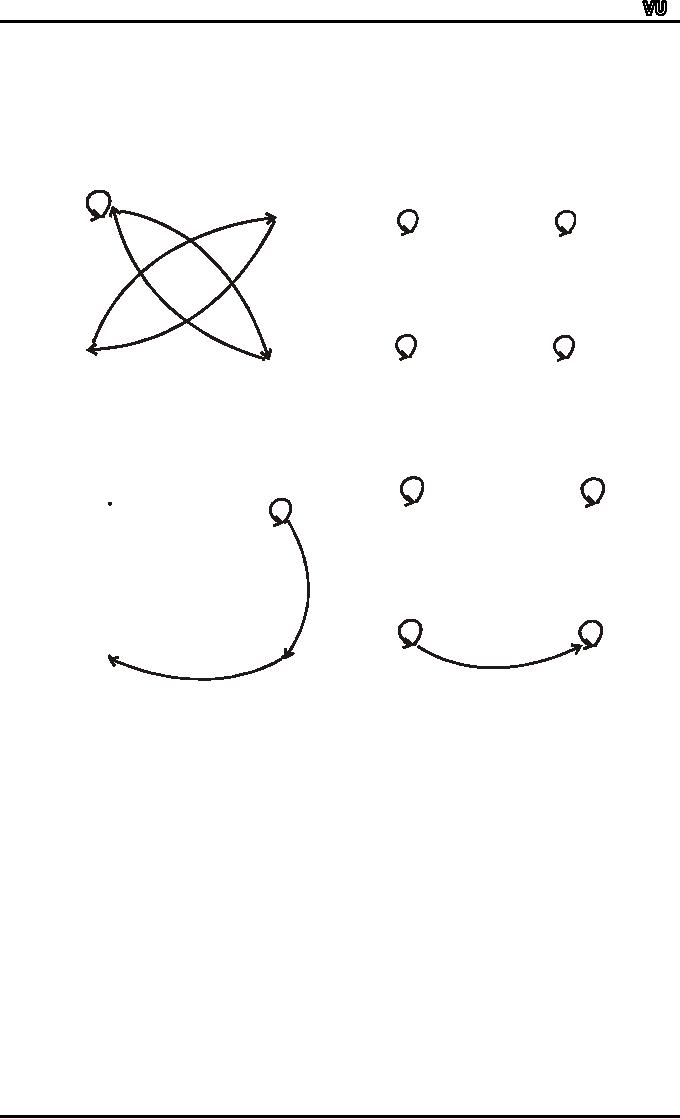
MTH001
Elementary Mathematics
2
1
1
2
4
4
3
3
R2 is
symmetric
R1 is
symmetric
1
2
1
2
4
3
4
3
R3 is
not symmetric since
there
R4 is
not symmetric since
are
arrows from 2 to 3 and
from
there
is an arrow from 4 to 3
3
to 4 but not
conversely
but
no arrow from 3 to 4
MATRIX
REPRESENTATION OF A SYMMETRIC
RELATION
Let
A
= {a1,
a2, ..., an}.
A
relation R on A is symmetric if and
only if for all
ai,
aj ∈
A, if (ai,
aj) ∈R then (aj,
ai)∈R.
Page
45
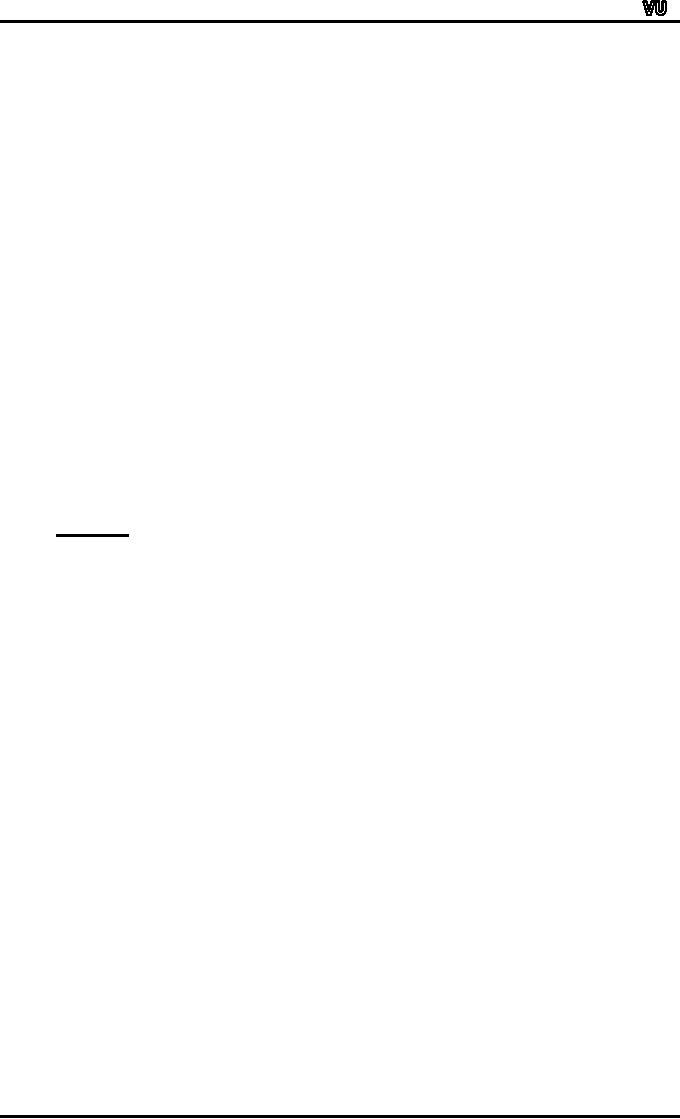
MTH001
Elementary Mathematics
Accordingly,
R is
symmetric
if the
elements
in the ith row are
the same as the elements in
the ith column of
the
t
matrix
M representing R. More precisely, M is a
symmetric matrix.i.e. M = M
EXAMPLE
The
relation R = {(1,3), (2,2),
(3,1), (3,3)}
on
A = {1,2,3} represented by the
following matrix M is
symmetric.
123
1
⎡0
0 1⎤
M
=
2
⎢0
1 0⎥
⎢
⎥
3
⎢1
0 1⎥
⎣
⎦
TRANSITIVE
RELATION
Let
R be a relation on a set A.R is
transitive if and only if
for all a, b, c ∈A,
if
(a, b) ∈R and
(b, c) ∈R then
(a, c) ∈R.
That
is, if aRb and bRc
then aRc.
In
words, if any one
element is related to a
second
and
that second element is
related to a third, then the
first is related to the
third.
Note
that the "first", "second"
and "third" elements need
not to be distinct.
REMARK
R
is not transitive iff there
are elements a, b, c in A such
that
If
(a,b) ∈R and
(b,c) ∈R but
(a,c) ∉R.
EXAMPLE
Let
A = {1, 2, 3, 4} and define
relations R1,
R2 and R3
on A
as
follows:
R1 =
{(1, 1), (1, 2),
(1, 3), (2,
3)}
R2 =
{(1, 2), (1, 4),
(2, 3), (3,
4)}
R3 =
{(2, 1), (2, 4),
(2, 3), (3,4)}
Then
R1 is
transitive because (1, 1),
(1, 2) are in R then to be
transitive relation
(1,2)
must be there and it belongs
to R Similarly for other
order pairs.
R2 is
not transitive since (1,2)
and (2,3) ∈
R2 but (1,3) ∉
R2.
R3 is
transitive.
DIRECTED
GRAPH OF A TRANSITIVE
RELATION
For
a transitive directed graph,
whenever there is an arrow
going from one point
to
the
second, and from the
second to the third, there
is an arrow going
directly
from the
first
to the
third.
EXAMPLE
Let
A = {1, 2, 3, 4} and define
relations R1,
R2 and R3
on A by
the
directed
graphs:
R1 =
{(1, 1), (1, 2),
(1, 3), (2,
3)}
R2 =
{(1, 2), (1, 4),
(2, 3), (3,
4)}
R3 =
{(2, 1), (2, 4),
(2, 3), (3,4)}
Page
46
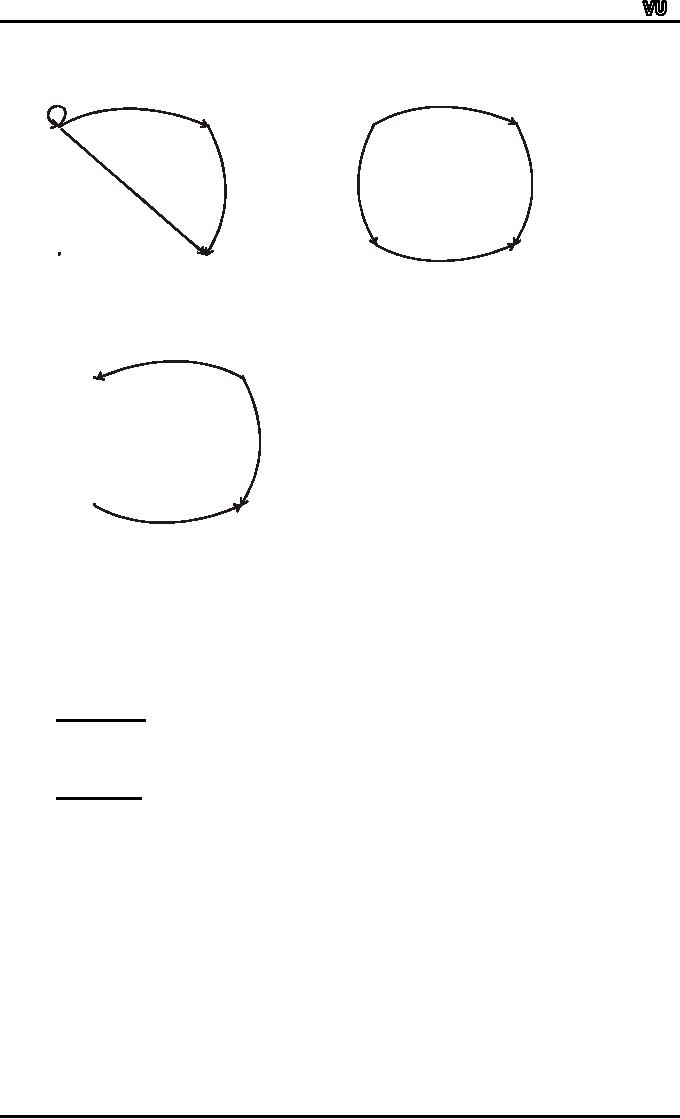
MTH001
Elementary Mathematics
1
1
2
2
4
3
4
3
R1 is
transitive
R2 is not
transitive since there
is
an
arrow from 1 to 2 and from
2
to
3 but no arrow from 1 to 3
2
1
directly
4
3
R3 is
transitive
EXERCISE:
Let
A = {1, 2, 3, 4} and define
the null relation φ
and
universal
relation
A �A
on A. Test these relations
for reflexive, symmetric
and
transitive
properties.
SOLUTION:
Reflexive:
∅
is
not reflexive since (1,1),
(2,2), (3,3), (4,4) ∉
∅.
(i)
A
�
A is
reflexive since (a,a) ∈
A � A for
all a ∈
A.
(ii)
Symmetric
For
the null relation ∅
on A to be
symmetric, it must
(i)
satisfy
the implication:
if
(a,b) ∈
∅ then
(a, b) ∈
∅.
Since
(a, b) ∈
∅ is
never true, the implication
is vacuously true or true by
default.
Hence
∅
is
symmetric.
The
universal relation A �
A is
symmetric, for it
contains
(ii)
all
ordered
pairs of elements of A.
Thus,
if
(a, b) ∈
A � A then
(b, a) ∈
A � A for
all a, b in A.
Transitive
Page
47
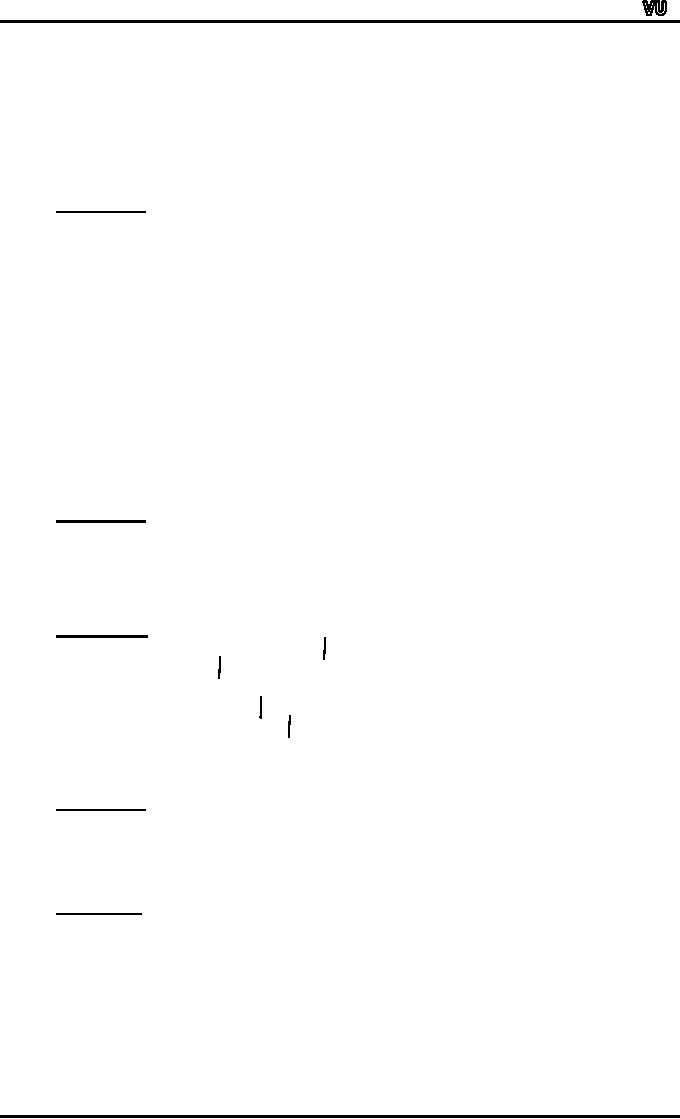
MTH001
Elementary Mathematics
The
null relation ∅
on A is
transitive, because
the
(i)
implication.
if
(a, b) ∈
∅ and
(b, c) ∈
∅ then
(a, c) ∈
∅ is
true by default,
since
the condition (a, b) ∈
∅ is
always false.
The
universal relation A �
A is
transitive for it contains
all ordered pairs of
(i)
elements
of A.
Accordingly,
if (a, b) ∈
A � A and
(b, c) ∈
A � A then
(a, c) ∈
A � A as
well.
EXERCISE:
Let
A
= {0, 1, 2} and
R
= {(0,2), (1,1), (2,0)} be a
relation on A.
1.
Is R reflexive? Symmetric?
Transitive?
2.
Which ordered pairs are
needed in R to make it a reflexive
and transitive
relation.
SOLUTION:
1.
R is not reflexive, since 0 ∈ A but
(0, 0) ∉R and
also 2 ∈
A
but (2, 2)
∉R.
R
is clearly symmetric.
R
is not transitive, since (0,
2) & (2, 0) ∈
R
but (0, 0) ∉R.
2.
For
R to be reflexive, it must contain
ordered pairs (0,0) and
(2,2).
For
R to be transitive,
we
note (0,2) and (2,0)
∈
but
(0,0) ∉R.
Also
(2,0) and (0,2) ∈R but
(2,2)∉R.
Hence
(0,0) and (2,2). Are
needed in R to make it a transitive
relation.
EXERCISE:
Define
a relation L on the set of
real numbers R
be defined as
follows:
for
all x, y ∈R, x L y ⇔
x <
y.
a.
Is L reflexive?
b.
Is L symmetric?
c.
Is L transitive?
SOLUTION:
a.
L is not reflexive, because x < x
for any real number
x.
(e.g.
1 < 1)
L
is not symmetric, because
for all x, y ∈R, if
b.
x
< y then y < x
(e.g.
0 < 1 but 1 < 0)
L
is transitive, because for
all, x, y, z ∈R, if x <
y
c.
and
y < z, then x < z.
(by
transitive law of order of
real numbers).
EXERCISE:
+
Define
a relation R on the set of
positive integers Z as
follows:
for
all a, b ∈Z+, a R b
iff
a �
b is
odd.
Determine
whether the relation
is
a.
reflexive
b.
symmetric c. transitive
SOLUTION:
Firstly,
recall that the product of
two positive integers
is
odd
if and only if both of them
are odd.
a.
reflexive
R
is not reflexive, because 2 ∈ Z+ but 2 R
2
for
2 �
2 = 4
which is not odd.
b.
symmetric
R
is symmetric, because
if
a R b then a �
b is
odd or equivalently b �
a is
odd
Page
48
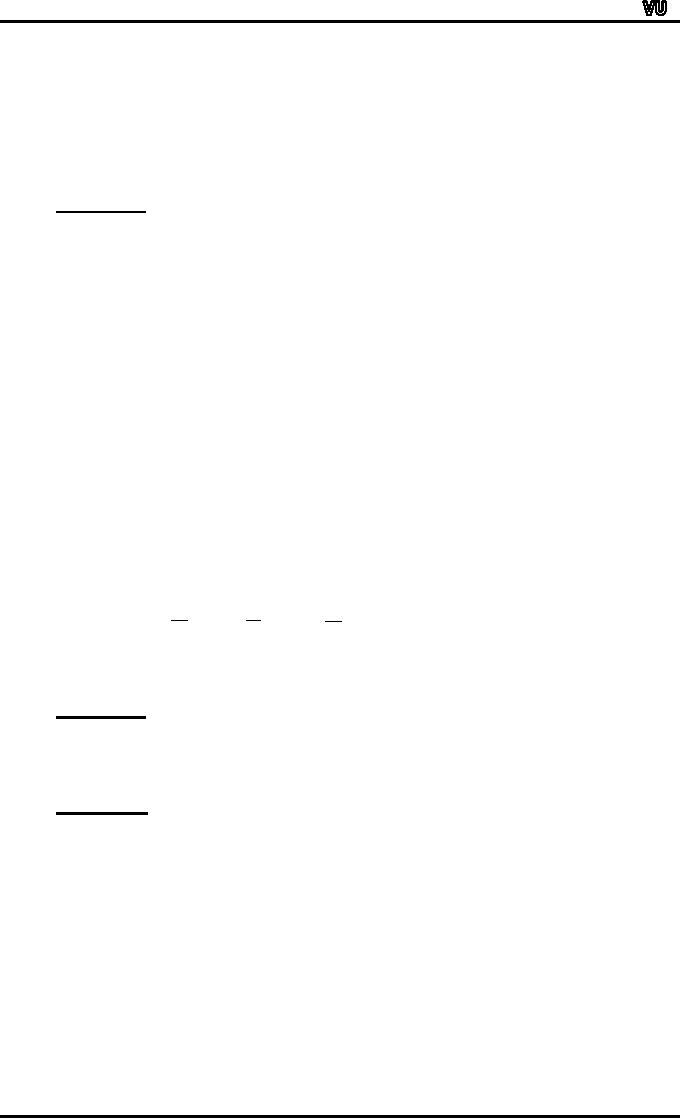
MTH001
Elementary Mathematics
(
b �
a = a
�
b) ⇒ b R a.
c.
transitive
R
is transitive, because if a R b then a
�
b
is
odd
⇒
both
"a" and "b" are
odd. Also bRc means b
�
c is
odd
⇒
both
"b" and "c" are
odd.
Now
if aRb and bRc, then
all of a, b, c are odd and
so a �
c
is
odd.
Consequently
aRc.
EXERCISE:
Let
"D" be the "divides"
relation on Z defined
as:
for
all m, n ∈Z, m D n⇔
m|n
Determine
whether D is reflexive, symmetric or
transitive. Justify your
answer.
SOLUTION:
Reflexive
Let
m ∈Z,
since every integer
divides
itself
so
m|m
∀
m ∈Z
therefore m D m ∀
m ∈Z
Accordingly
D is reflexive
Symmetric
Let
m, n ∈
Z
and suppose m D n.
By
definition of D, this means
m|n (i.e.= an
integer)
Clearly,
then it is not necessary
that = an integer.
Accordingly,
if m D n then n D m, ∀
m, n
∈Z
Hence
D is not symmetric.
Transitive
Let
m, n, p ∈Z and
suppose m D n and n D p.
Now
m D n ⇒ m|n ⇒ = an
integer.
Also
n D p ⇒ n|p ⇒ = an
integer.
*
⎛
p
⎞
(an
in⎛)
n
⎞an
int)
=p
We
note
=
t
*(
⎜ ⎟
⎜ ⎟
m
= an i⎝
tn
⎠
n
⎝
m⎠
⇒
m|p
and so mDp
Thus
if mDn and nDp then
mDp ∀
m, n, p
∈Z
Hence
D is transitive.
EXERCISE:
Let
A be the set of people
living in the world today.
A
binary
relation R is defined on A as
follows:
for
all p, q ∈A, pRq
⇔
p
has the same first
name as q.
Determine
whether the relation R is
reflexive, symmetric and/or
transitive.
SOLUTION:
a.
Reflexive
Since
every person has the
same first name as his/her
self.
Hence
for all p ∈
A,
pRp. Thus, R is
reflexive.
b.
Symmetric:
Let
p, q ∈A
and suppose pRq.
⇔
p
has the same first
name as q.
⇔
q
has the same first
name as p.
⇔
qRp
Thus
if pRq then qRp ∀
p,q
∈A.
⇒
R is
symmetric.
a.
Transitive
Let
p, q, s ∈A and
suppose p R q and
qRr.
Page
49
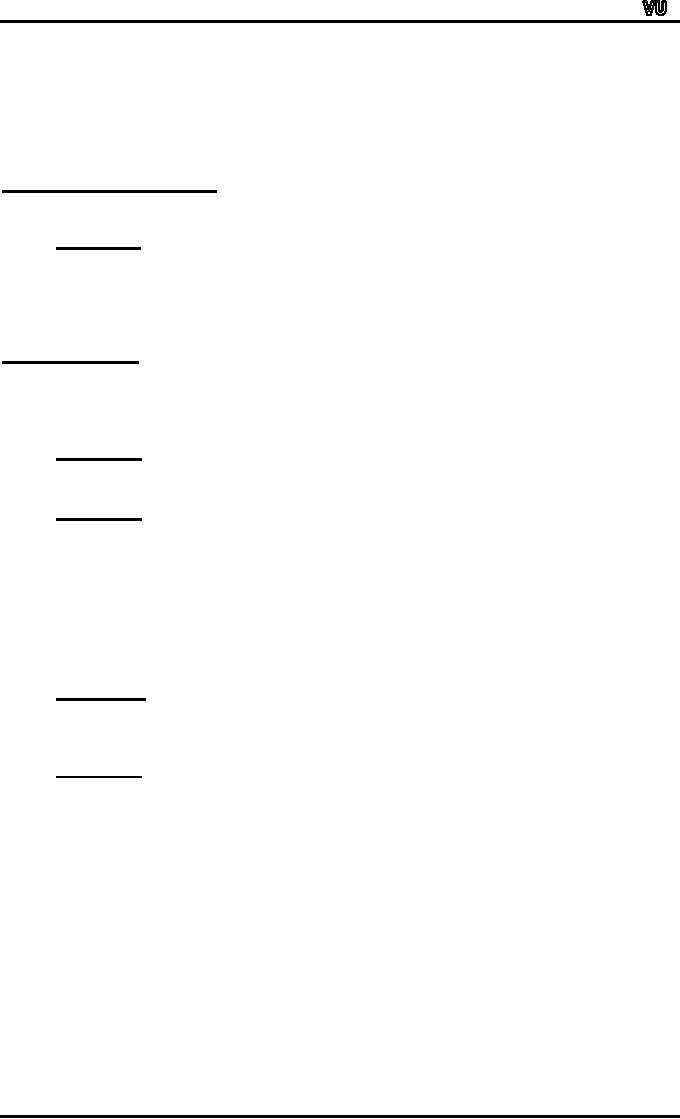
MTH001
Elementary Mathematics
Now
pRq ⇔p has
the same first name as
q
and
qRr ⇔
q
has the same first
name as r.
Consequently,
p has the same first
name as r.
⇔
pRr
Thus,
if pRq and qRs then
pRr, ∀
p, q, r
∈A.
Hence
R is transitive.
EQUIVALENCE
RELATION:
Let
A be a non-empty set and R a
binary relation on A. R is an
equivalence
relation
if, and only if, R is
reflexive, symmetric, and
transitive.
EXAMPLE:
Let
A = {1, 2, 3, 4} and
R
= {(1,1), (2,2), (2,4),
(3,3), (4,2), (4,4)}
be
a binary relation on A.
Note
that R is reflexive, symmetric
and transitive, hence
an
equivalence
relation.
CONGRUENCES:
Let
m and n be integers and d be a
positive integer. The
notation
m
≡
n
(mod d) means that
d
| (m n) {d divides m minus n}.There
exists an integer k such
that
(m
n) = d ⋅
k
EXAMPLE:
c.
Is 22 ≡ 1(mod
3)?
Is
5 ≡ +10
(mod 3)?
b.
d.
Is 7 ≡
7
(mod 3)?
Is
14 ≡
4
(mod 3)?
d.
SOLUTION
a.
Since 22-1 = 21 = 3�7.
Hence
3|(22-1), and so 22 ≡
1
(mod 3)
b.
Since 5 10 = - 15 = 3 �
(-5),
Hence
3|((-5)-10), and so - 5 ≡
10
(mod 3)
c.
Since 7 7 = 0 = 3 �
0
Hence
3|(7-7), and so 7 ≡
7
(mod 3)
d.
Since 14 4 = 10, and 3 / 10
because 10 ≠
3⋅ k for
any integer
k.
Hence 14 ≡
4
(mod 3).
EXERCISE:
Define
a relation R on the set of
all integers Z as
follows:
for
all integers m and n, m R n ⇔ m ≡
n
(mod 3)
Prove
that R is an equivalence
relation.
SOLUTION:
1.
R is reflexive.
R
is reflexive iff for all m
∈Z,
m R m.
By
definition of R, this means
that
For
all m ∈Z, m ≡
m
(mod 3)
Since
m m = 0 = 3 �0.
Hence
3|(m-m), and so m ≡
m
(mod 3)
⇔
mRm
⇒
R is
reflexive.
2.
R is symmetric.
R
is symmetric iff for all m,
n ∈Z
if
m R n then n R m.
⇒
m≡n
(mod 3)
Now
mRn
⇒
3|(m-n)
⇒
m-n
= 3k, for some integer
k.
⇒
n
m = 3(-k), -k ∈Z
Page
50

MTH001
Elementary Mathematics
⇒
3|(n-m)
⇒
n
≡
m
(mod 3)
⇒
nRm
Hence
R is symmetric.
1.
R is transitive
R
is transitive iff for all m,
n, p ∈Z,
if
mRn and nRp then
mRp
Now
mRn and nRp means m
≡
n
(mod 3) and n ≡
p
(mod 3)
⇒
3|(m-n)
and
3|(n-p)
⇒
(m-n) =
3r
for
some r, s ∈Z
and
(n-p)
= 3s
Adding
these two equations, we
get,
(m
n) + (n p) = 3 r + 3 s
⇒
m p = 3 (r
+ s),where r + s ∈Z
⇒
3|(m
p)
⇒
m ≡ p (mod 3)
⇔
m
Rp
Hence
R is transitive. R being reflexive,
symmetric and transitive, is
an
equivalence
relation.
Page
51
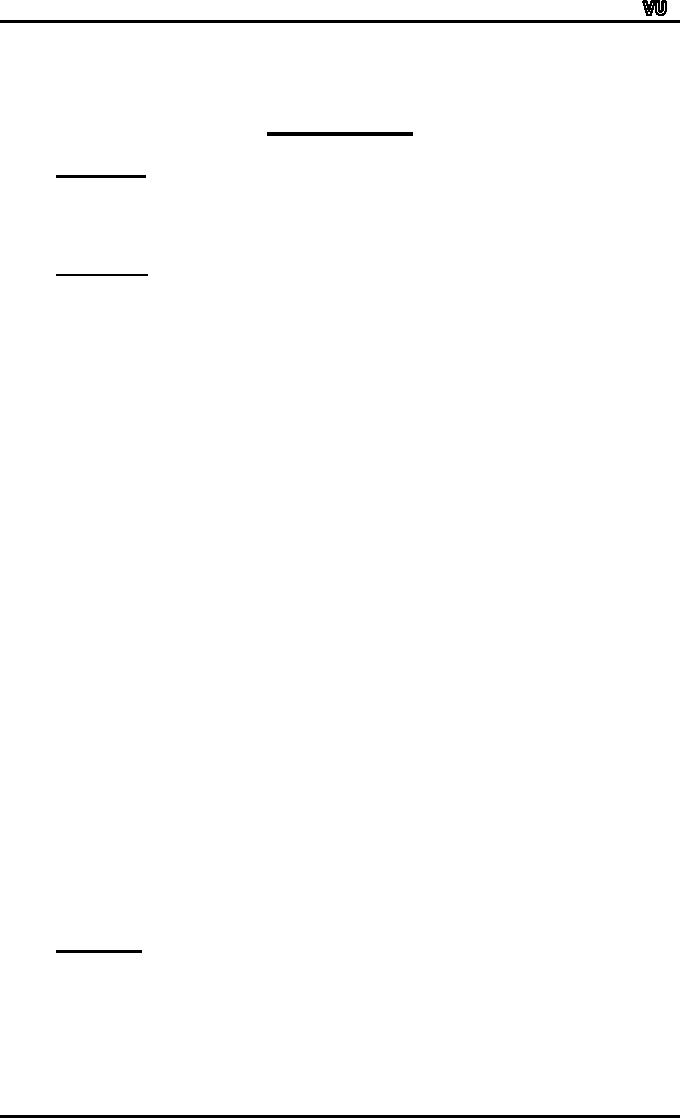
MTH001
Elementary Mathematics
LECTURE
# 10
EXERCISE:
Suppose
R and S are binary relations
on a set A.
a.
If R and S are reflexive, is R
∩
S
reflexive?
b.
If R and S are symmetric, is R
∩
S
symmetric?
c.
If R and S are transitive, is R
∩
S
transitive?
SOLUTION:
a.
R ∩
S is
reflexive:
Suppose
R and S are
reflexive.
Then
by definition of reflexive
relation
∀
a ∈A
(a,a) ∈R and
(a,a) ∈S
⇒
∀
a ∈ A (a,a)
∈
R ∩ S
(by
definition of intersection)
Accordingly,
R ∩
S is
reflexive.
b.
R ∩
S is
symmetric.
Suppose
R and S are
symmetric.
To
prove R ∩
S is
symmetric we need to show
that
∀
a, b
∈
A, if
(a,b) ∈
R ∩ S then
(b,a) ∈
R ∩ S.
Suppose
(a,b) ∈
R ∩ S.
⇒
(a,b)
∈
R
and (a,b) ∈
S
(
by the definition of Intersection of
two sets )
Since
R is symmetric, therefore if (a,b)
∈
R
then
(b,a)
∈
R.
Similarly S is symmetric, so if (a,b)
∈
S
then (b,a) ∈
S.
Thus
(b,a) ∈
R
and (b,a) ∈
S
⇒
(b,a)
∈
R ∩ S
(by
definition of intersection)
Accordingly,
R ∩
S is
symmetric.
c.
R∩S is
transitive.
Suppose
R and S are
transitive.
To
prove R∩S is transitive
we must show that
∀
a,b,c,
∈A,
if (a,b) ∈
R∩S
and (b,c) ∈
R∩S
then
(a,c) ∈R∩S.
Suppose
(a,b) ∈R∩S and
(b,c) ∈R∩S
⇒
(a,b)
∈R
and (a,b) ∈S and
(b,c) ∈R and
(b,c) ∈S
Since
R is transitive, therefore
if
(a,b) ∈R and
(b,c) ∈R then
(a,c) ∈R.
Also
S is transitive, so (a,c) ∈S
Hence
we conclude that (a,c) ∈R and
(a,c) ∈S
and
so (a,c) ∈R∩S (by
definition of intersection)
Accordingly,
R∩S
is transitive.
EXAMPLE:
Let
A = {1,2,3,4}
and
let R and S be transitive
binary relations on A defined
as:
R
= {(1,2), (1,3), (2,2),
(3,3), (4,2), (4,3)}
and
S
= {(2,1), (2,4),(3,3)}
Then
R ∪
S =
{(1,2), (1,3), (2,1), (2,2),
(2,4), (3,3), (4,2),
(4,3)}
We
note (1,2) and (2,1)
∈R∪S,
but (1,1) ∉
R∪S
Page
52
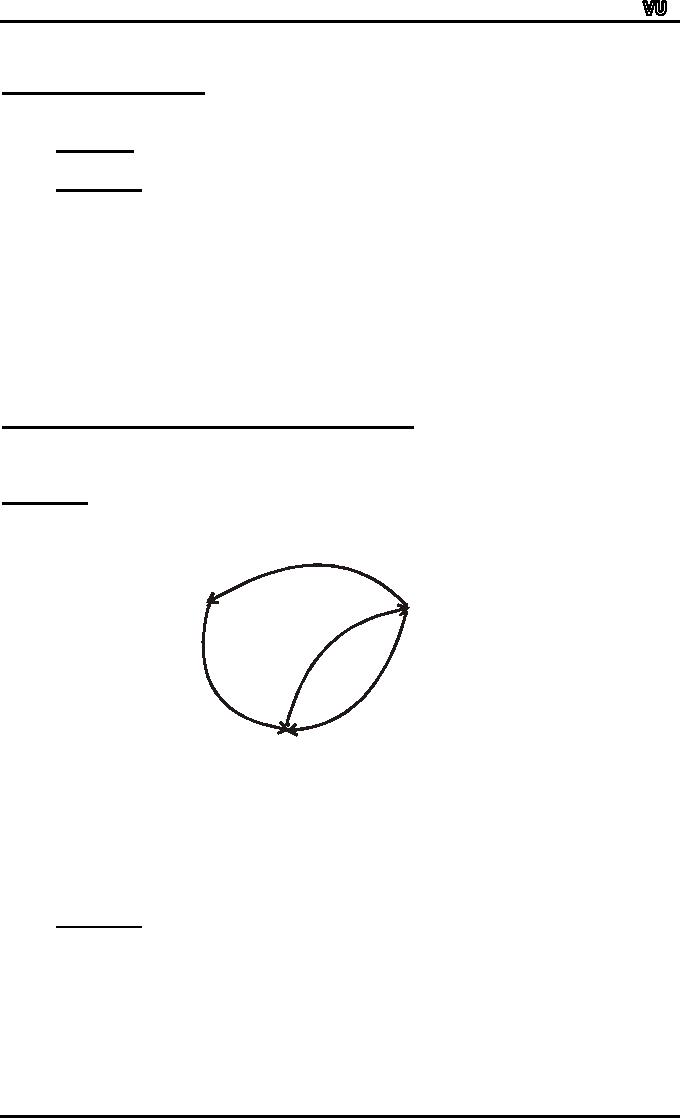
MTH001
Elementary Mathematics
Hence
R∪S
is not transitive.
IRREFLEXIVE
RELATION:
Let
R be a binary relation on a set A. R is
irreflexive iff for all
a∈A,(a,a)
∉R.
That
is, R is irreflexive if no element in A
is related to itself by R.
REMARK:
R
is not irreflexive iff there
is an element a∈A such
that (a,a) ∈R.
EXAMPLE:
Let
A = {1,2,3,4} and define the
following
relations
on A:
R1 =
{(1,3), (1,4), (2,3), (2,4),
(3,1), (3,4)}
R2 =
{(1,1), (1,2), (2,1), (2,2),
(3,3), (4,4)}
R3 =
{(1,2), (2,3), (3,3),
(3,4)}
Then
R1 is
irreflexive since no element of A is
related to itself in R1.
i.e.
(1,1)∉ R1,
(2,2) ∉
R1,
(3,3) ∉
R1,(4,4) ∉
R1
R2 is
not irreflexive, since all
elements of A are related to
themselves in R2
R3 is
not irreflexive since (3,3)
∈R3.
Note that R3 is not
reflexive.
NOTE:
A
relation may be neither
reflexive nor
irreflexive.
DIRECTED
GRAPH OF AN IRREFLEXIVE
RELATION:
Let
R be an irreflexive
relation on a
set A. Then by
definition,
no element of
A
is
related
to itself by R. Accordingly, there is no
loop at each point of A in
the
directed
graph of R.
EXAMPLE:
Let
A = {1,2,3}
and
R = {(1,3), (2,1), (2,3),
(3,2)} be represented by
the
directed
graph.
1
2
MATRIX
REPRESENTATION OF AN IRREFLEXIVE
RELATION
Let
R be an irreflexive relation on a set A.
Then by definition, no element of A
is
related
to itself by R.
Since
the self related elements
are represented by 1's on
the main diagonal of
the
matrix
representation of the relation, so
for irreflexive relation R,
the matrix will
contain
all 0's in its main
diagonal.
It
means that a relation is
irreflexive if in its matrix
representation the
diagonal
elements
are all zero, if one of
them is not zero the we
will say that
the
relation
is
not
irreflexive.
EXAMPLE:
Let
A = {1,2,3} and R = {(1,3),
(2,1), (2,3), (3,2)}
be
represented
by
the matrix
1 2 3
1
⎡0
0 1⎤
M
=
2
⎢1
0 1⎥
⎢
⎥
3
⎢0
1 0⎥
⎣
⎦
Page
53
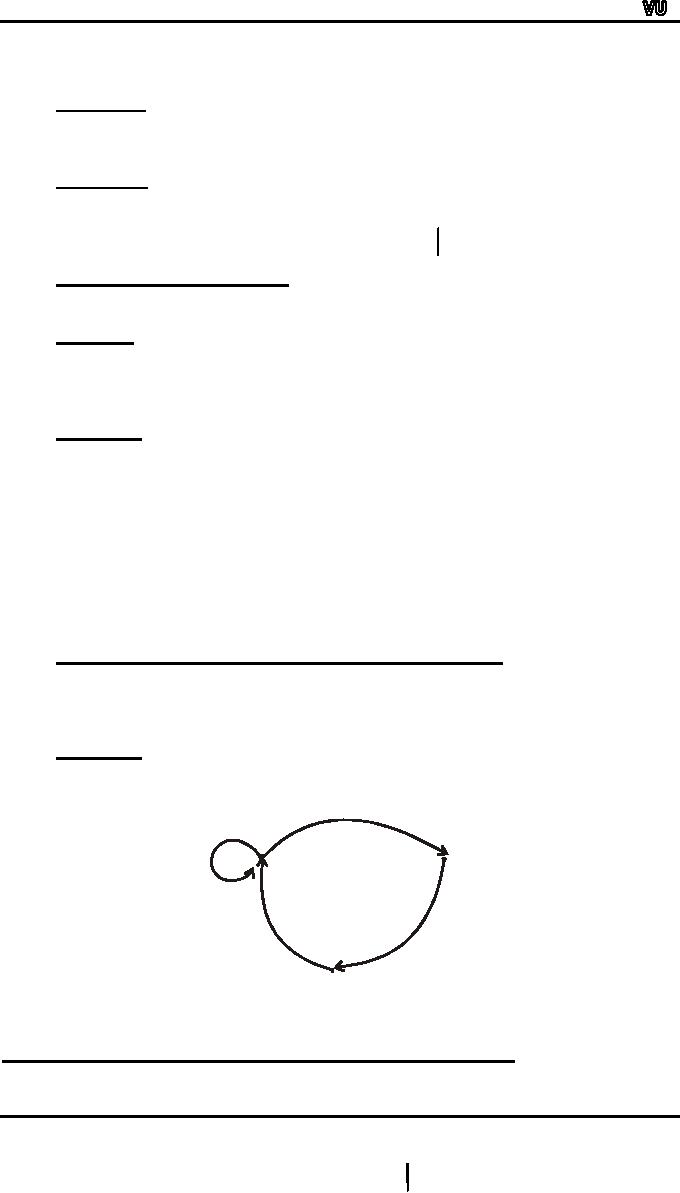
MTH001
Elementary Mathematics
Then
R is irreflexive, since all
elements in the main
diagonal are 0's.
EXERCISE:
Let
R be the relation on the set
of integers Z
defined
as:
for
all a,b ∈Z, (a,b)
∈R
⇔
a >
b.
Is
R irreflexive?
SOLUTION:
R
is irreflexive if for all a ∈Z,
(a,a) ∉R.
Now
by the definition of given
relation R,
for
all a ∈Z, (a,a)
∉R
since a > a.
Hence
R is irreflexive.
ANTISYMMETRIC
RELATION:
Let
R be a binary relation on a set
A.R is anti-symmetric
iff
∀a, b ∈A if (a,b)
∈R
and (b,a) ∈R then a =
b.
REMARK:
1.
R is not anti-symmetric
iff
there are elements a and b
in A such
that
(a,b) ∈R and
(b,a) ∈R but a
≠
b.
2.
The properties of being
symmetric
and
being
anti-symmetric
are
not negative of each
other.
EXAMPLE:
Let
A = {1,2,3,4} and define the
following relations on A.
R1 =
{(1,1),(2,2),(3,3)}
R2 =
{(1,2),(2,2), (2,3), (3,4),
(4,1)}
R3={(1,3),(2,2), (2,4),
(3,1), (4,2)}
R4={(1,3),(2,4), (3,1),
(4,3)}
R1 is
anti-symmetric and symmetric
.
R2 is
anti-symmetric but not
symmetric because (1,2)
∈ R2but (2,1) ∉
R2.
R3 is
not anti-symmetric since
(1,3) & (3,1) ∈
R3 but 1 ≠
3.
Note
that R3 is symmetric.
(1,3)
& (3,1) ∈
R4 but 1 ≠
3
nor
R4is
neither anti-symmetric
because
because
(2,4) ∈
R4
but (4,2) ∉R4
symmetric
DIRECTED
GRAPH OF AN ANTISYMMETRIC
RELATION:
Let
R be an anti-symmetric relation on a set
A. Then by definition, no two
distinct
elements
of A are related to each
other.
Accordingly,
there is no pair of arrows
between two distinct
elements of A in the
directed
graph of R.
EXAMPLE:
Let
A = {1,2,3} And R be the relation
defined on
A
is
R
={(1,1), (1,2), (2,3),
(3,1)}.Thus R is represented by the
directed graph as
1
2
3
R
is anti-symmetric, since there is no
pair of arrows between two
distinct points in
A.
MATRIX
REPRESENTATION OF AN ANTISYMMETRIC
RELATION:
Page
54
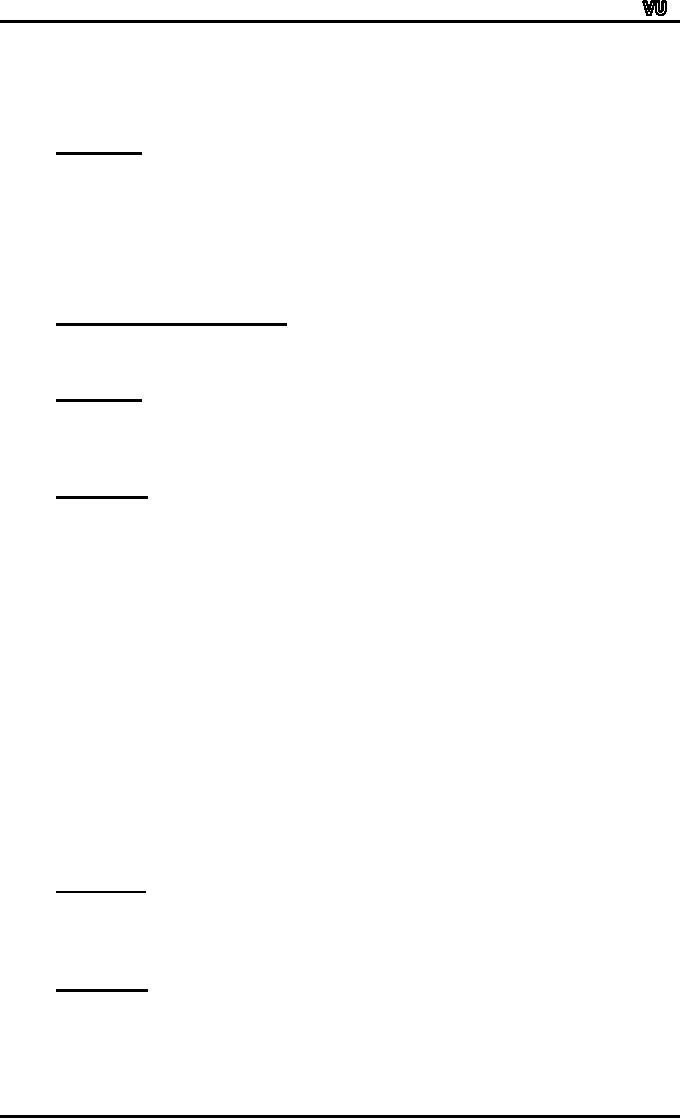
MTH001
Elementary Mathematics
Let
R be an anti-symmetric relation on a
set
if
(ai,
aj) ∈R for i
≠
j
then (ai, aj)
∉R.
A
= {a1,
a2, ..., an}.
Then
Thus
in the matrix representation of R
there is a 1 in the ith row
and jth column
iff
the
jth row and ith
column contains 0 vice
versa.
EXAMPLE:
Let
A = {1,2,3} and a
relation
R
= {(1,1), (1,2), (2,3),
(3,1)}on A be represented by the
matrix.
1 2 3
1
⎡1
1 0⎤
M
=
2
⎢0
0 1⎥
⎢
⎥
3
⎢1
0 0⎥
⎣
⎦
Then
R is anti-symmetric as clear by the
form of matrix M
PARTIAL
ORDER RELATION:
Let
R be a binary relation defined on a
set A. R is a partial order
relation,if and
only
if, R is reflexive,
antisymmetric, and
transitive.
The set A together with
a
partial
ordering R is called a partially
ordered set or
poset.
EXAMPLE:
Let
R be the set of real numbers
and define the"less than
or
equal
to" , on R as follows:
for
all real numbers x and y in
R.x ≤y ⇔
x < y or x =
y
Show
that ≤
is a
partial order
relation.
SOLUTION:
≤
is
reflexive
For
≤
to be
reflexive means that x ≤
x
for all x ∈R
But
x ≤
x
means that x < x or x = x and x = x is
always true.
Hence
under this relation every
element is related to
itself.
≤
is
anti-symmetric.
For
≤
to be
anti-symmetric means
that
∀
x,y
∈R,
if x ≤
y
and y ≤
x,
then x = y.
This
follows from the definition
of ≤
and
the trichotomy
property,
which says
that
"given
any real numbers x and y,
exactly one of thefollowing
holds:
x
< y or x = y or x > y"
≤
is
transitive
For
≤
to be
transitive means that
∀
x,y,z
∈R,
if x≤
y
and y ≤
z
then x ≤
z.
This
follows from the definition
of ≤
and
the transitive property of
order of real
numbers,
which says that "given
any real numbers x, y and
z,
if
x < y and y < z then x <
z"
Thus
≤
being
reflexive, anti-symmetric and
transitive is a partial order
relation on
R.
EXERCISE:
Let
A be a non-empty set and
P(A) the power set of
A.
Define
the "subset" relation, ⊆, as
follows:
for
all X,Y ∈
P(A), X
⊆
Y ⇔ ∀ x, iff x
∈X
then x ∈Y.
Show
that ⊆
is a
partial order
relation.
SOLUTION:
1.
⊆
is
reflexive
Let
X ∈
P(A).
Since every set is a subset
of itself, therefore
X
⊆
X, ∀ X ∈P(A).
Accordingly
⊆
is
reflexive.
Page
55
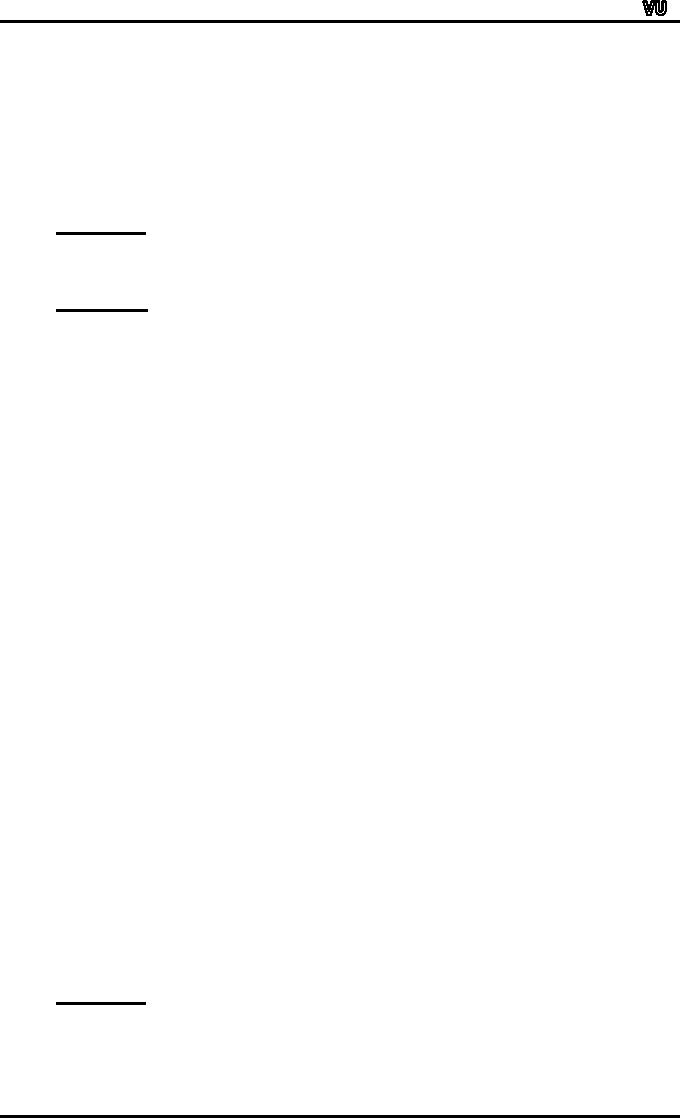
MTH001
Elementary Mathematics
2.
⊆
is
anti-symmetric
Let
X, Y ∈P(A)
and suppose X ⊆
Y
and Y ⊆
X.Then by
definition of equality of
two
sets
it follows that X = Y.
Accordingly,
⊆
is
anti-symmetric.
3.
⊆
is
transitive
Let
X, Y, Z ∈P(A)
and suppose X ⊆
Y
and Y ⊆
Z.
Then by the
transitive
property
of subsets "if U ⊆
V
and V ⊆
W
then U ⊆
W"it
follows X ⊆
Z.
Accordingly
⊆
is
transitive.
EXERCISE:
Let
"|" be the "divides"
relation on a set A of
positive
integers.
That
is, for all a, b ∈A, a|b
⇔
b = k
⋅a
for
some
integer k.
Prove
that | is a partial order
relation on A.
SOLUTION:
1.
"|" is
reflexive. [We
must show that, ∀
a ∈A,
a|a]
Suppose
a ∈A.
Then a = 1⋅a and so
a|a by definition of
divisibility.
2.
"|" is anti-symmetric
[We
must show that for
all a, b ∈A, if a|b
and b|a then
a=b]
Suppose
a|b and b|a
By
definition of divides there
are integers k1, and k2
such that
b
= k1 ⋅a
a
= k2 ⋅b
and
Now
b = k1 ⋅a
=
k1⋅(k2
⋅
b)
(by
substitution)
=
(k1 ⋅k2) ⋅b
Dividing
both sides by b gives
1
= k1 ⋅k2
Since
a, b ∈A,
where A is the set of
positive integers, so
the
equations
b
= k1⋅a
a
= k2 ⋅b
and
implies
that k1 and k2 are both
positive integers. Now
the
equation
k1⋅k2
=1
can
hold only when k1 = k2 =
1
Thus
a = k2⋅b=1
⋅b=b
i.e.,
a = b
3.
"|" is transitive
[We
must show that ∀a,b,c∈A
if a|b and b|c than
a|c]
Suppose
a|b and b|c
By
definition of divides, there
are integers k1 and k2 such
that
b
= k1 ⋅a
c
= k2 ⋅b
and
Now
c = k2 ⋅b
=
k2 ⋅(k1
⋅a)
(by substitution)
=
(k2 ⋅k1) ⋅a
(by associative law
under
multiplication)
=
k3 ⋅a
where
k3= k2⋅k1 is an
integer
⇒
a|c
by
definition of divides
Thus
"|" is a partial order
relation on A.
EXERCISE:
Let
"R" be the relation defined
on the set of integers Z as
follows:
r
for
all a, b ∈Z, aRb
iff b=a for some
positive integer r.
Show
that R is a partial order on
Z.
Page
56

MTH001
Elementary Mathematics
SOLUTION:
Let
a, b ∈Z
and suppose aRb and
bRa. Then there are
positive
integers
r and s such that
r
s
b
= a and
a=b
s
Now,
a=b
r s
=
(a )
by
substitution
rs
=a
⇒
rs
=1
Since
r and s are positive
integers, so this equation
can hold if, and
only if,
r
=1
and s = 1
1
and
then a = bs = b = b
i.e.,
a = b
Thus
R is anti-symmetric.
3.
Let a, b, c
∈Z
and suppose aRb and
bRc.
Then
there are positive integers
r and s such that
r
s
b
= a and
c=b
r
Now
c = b
r s
=
(a )
(by
substitution)
rs
t
=a
=a
(where
t = rs is also a positive
integer)
Hence
by definition of R, aRc. Therefore, R is
transitive.
Accordingly,
R is a partial
order relation on
Z.
Page
57
Table of Contents:
- Recommended Books:Set of Integers, SYMBOLIC REPRESENTATION
- Truth Tables for:DE MORGAN’S LAWS, TAUTOLOGY
- APPLYING LAWS OF LOGIC:TRANSLATING ENGLISH SENTENCES TO SYMBOLS
- BICONDITIONAL:LOGICAL EQUIVALENCE INVOLVING BICONDITIONAL
- BICONDITIONAL:ARGUMENT, VALID AND INVALID ARGUMENT
- BICONDITIONAL:TABULAR FORM, SUBSET, EQUAL SETS
- BICONDITIONAL:UNION, VENN DIAGRAM FOR UNION
- ORDERED PAIR:BINARY RELATION, BINARY RELATION
- REFLEXIVE RELATION:SYMMETRIC RELATION, TRANSITIVE RELATION
- REFLEXIVE RELATION:IRREFLEXIVE RELATION, ANTISYMMETRIC RELATION
- RELATIONS AND FUNCTIONS:FUNCTIONS AND NONFUNCTIONS
- INJECTIVE FUNCTION or ONE-TO-ONE FUNCTION:FUNCTION NOT ONTO
- SEQUENCE:ARITHMETIC SEQUENCE, GEOMETRIC SEQUENCE:
- SERIES:SUMMATION NOTATION, COMPUTING SUMMATIONS:
- Applications of Basic Mathematics Part 1:BASIC ARITHMETIC OPERATIONS
- Applications of Basic Mathematics Part 4:PERCENTAGE CHANGE
- Applications of Basic Mathematics Part 5:DECREASE IN RATE
- Applications of Basic Mathematics:NOTATIONS, ACCUMULATED VALUE
- Matrix and its dimension Types of matrix:TYPICAL APPLICATIONS
- MATRICES:Matrix Representation, ADDITION AND SUBTRACTION OF MATRICES
- RATIO AND PROPORTION MERCHANDISING:Punch recipe, PROPORTION
- WHAT IS STATISTICS?:CHARACTERISTICS OF THE SCIENCE OF STATISTICS
- WHAT IS STATISTICS?:COMPONENT BAR CHAR, MULTIPLE BAR CHART
- WHAT IS STATISTICS?:DESIRABLE PROPERTIES OF THE MODE, THE ARITHMETIC MEAN
- Median in Case of a Frequency Distribution of a Continuous Variable
- GEOMETRIC MEAN:HARMONIC MEAN, MID-QUARTILE RANGE
- GEOMETRIC MEAN:Number of Pupils, QUARTILE DEVIATION:
- GEOMETRIC MEAN:MEAN DEVIATION FOR GROUPED DATA
- COUNTING RULES:RULE OF PERMUTATION, RULE OF COMBINATION
- Definitions of Probability:MUTUALLY EXCLUSIVE EVENTS, Venn Diagram
- THE RELATIVE FREQUENCY DEFINITION OF PROBABILITY:ADDITION LAW
- THE RELATIVE FREQUENCY DEFINITION OF PROBABILITY:INDEPENDENT EVENTS